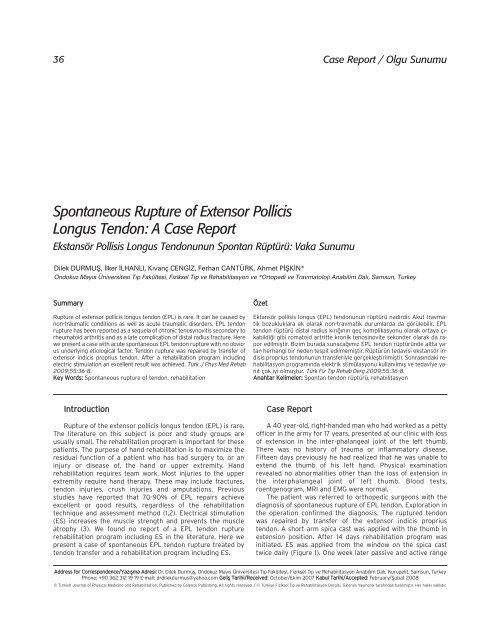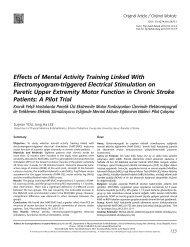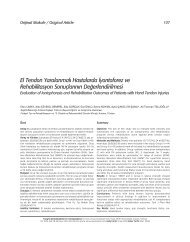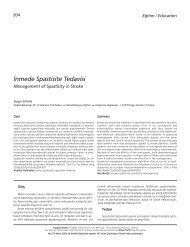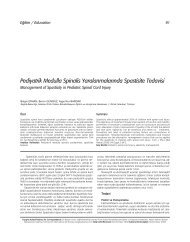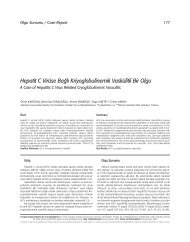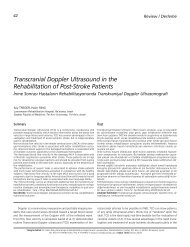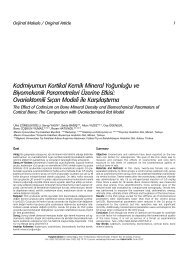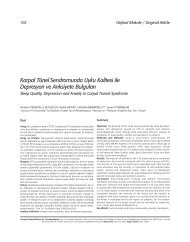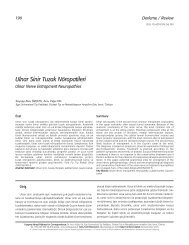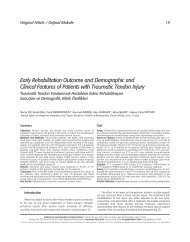Spontaneous Rupture of Extensor Pollicis Longus ... - FTR Dergisi
Spontaneous Rupture of Extensor Pollicis Longus ... - FTR Dergisi
Spontaneous Rupture of Extensor Pollicis Longus ... - FTR Dergisi
You also want an ePaper? Increase the reach of your titles
YUMPU automatically turns print PDFs into web optimized ePapers that Google loves.
36<br />
<strong>Spontaneous</strong> <strong>Rupture</strong> <strong>of</strong> <strong>Extensor</strong> <strong>Pollicis</strong><br />
<strong>Longus</strong> Tendon: A Case Report<br />
Ekstansör Pollisis <strong>Longus</strong> Tendonunun Spontan Rüptürü: Vaka Sunumu<br />
Summary<br />
<strong>Rupture</strong> <strong>of</strong> extensor pollicis longus tendon (EPL) is rare. It can be caused by<br />
non-traumatic conditions as well as acute traumatic disorders. EPL tendon<br />
rupture has been reported as a sequela <strong>of</strong> chronic tenosynovitis secondary to<br />
rheumatoid arthritis and as a late complication <strong>of</strong> distal radius fracture. Here<br />
we present a case with acute spontaneous EPL tendon rupture with no obvious<br />
underlying etiological factor. Tendon rupture was repaired by transfer <strong>of</strong><br />
extensor indicis proprius tendon. After a rehabilitation program including<br />
electric stimulation an excellent result was achieved. Turk J Phys Med Rehab<br />
2009;55:36-8.<br />
Key Words: <strong>Spontaneous</strong> rupture <strong>of</strong> tendon, rehabilitation<br />
Özet<br />
Case Report / Olgu Sunumu<br />
Dilek DURMUfi, ‹lker ‹LHANLI, K›vanç CENG‹Z, Ferhan CANTÜRK, Ahmet P‹fiK‹N*<br />
Ondokuz May›s Üniversitesi T›p Fakültesi, Fiziksel T›p ve Rehabilitasyon ve *Ortopedi ve Travmatoloji Anabilim Dal›, Samsun, Turkey<br />
Introduction<br />
<strong>Rupture</strong> <strong>of</strong> the extensor pollicis longus tendon (EPL) is rare.<br />
The literature on this subject is poor and study groups are<br />
usually small. The rehabilitation program is important for these<br />
patients. The purpose <strong>of</strong> hand rehabilitation is to maximize the<br />
residual function <strong>of</strong> a patient who has had surgery to, or an<br />
injury or disease <strong>of</strong>, the hand or upper extremity. Hand<br />
rehabilitation requires team work. Most injuries to the upper<br />
extremity require hand therapy. These may include fractures,<br />
tendon injuries, crush injuries and amputations. Previous<br />
studies have reported that 70-90% <strong>of</strong> EPL repairs achieve<br />
excellent or good results, regardless <strong>of</strong> the rehabilitation<br />
technique and assessment method (1,2). Electrical stimulation<br />
(ES) increases the muscle strength and prevents the muscle<br />
atrophy (3). We found no report <strong>of</strong> a EPL tendon rupture<br />
rehabilitation program including ES in the literature. Here we<br />
present a case <strong>of</strong> spontaneous EPL tendon rupture treated by<br />
tendon transfer and a rehabilitation program including ES.<br />
Ektansör pollisis longus (EPL) tendonunun rüptürü nadirdir. Akut travmatik<br />
bozukluklara ek olarak non-travmatik durumlarda da görülebilir. EPL<br />
tendon rüptürü distal radius k›r›¤›n›n geç komplikasyonu olarak ortaya ç›kabildi¤i<br />
gibi romatoid artritte kronik tenosinovite sekonder olarak da rapor<br />
edilmifltir. Bizim burada sunaca¤›m›z EPL tendon rüptüründe altta yatan<br />
herhangi bir neden tespit edilmemifltir. Rüptürün tedavisi ekstansör indisis<br />
proprius tendonunun transferiyle gerçeklefltirilmifltir. Sonras›ndaki rehabilitasyon<br />
program›nda elektrik stimülasyonu kullan›lm›fl ve tedaviye yan›t<br />
çok iyi olmufltur. Türk Fiz T›p Rehab Derg 2009;55:36-8.<br />
Anahtar Kelimeler: Spontan tendon rüptürü, rehabilitasyon<br />
Case Report<br />
A 40 year-old, right-handed man who had worked as a petty<br />
<strong>of</strong>ficer in the army for 17 years, presented at our clinic with loss<br />
<strong>of</strong> extension in the inter-phalangeal joint <strong>of</strong> the left thumb.<br />
There was no history <strong>of</strong> trauma or inflammatory disease.<br />
Fifteen days previously he had realized that he was unable to<br />
extend the thumb <strong>of</strong> his left hand. Physical examination<br />
revealed no abnormalities other than the loss <strong>of</strong> extension in<br />
the interphalangeal joint <strong>of</strong> left thumb. Blood tests,<br />
roentgenogram, MRI and EMG were normal.<br />
The patient was referred to orthopedic surgeons with the<br />
diagnosis <strong>of</strong> spontaneous rupture <strong>of</strong> EPL tendon. Exploration in<br />
the operation confirmed the diagnosis. The ruptured tendon<br />
was repaired by transfer <strong>of</strong> the extensor indicis proprius<br />
tendon. A short arm spica cast was applied with the thumb in<br />
extension position. After 14 days rehabilitation program was<br />
initiated. ES was applied from the window on the spica cast<br />
twice daily (Figure 1). One week later passive and active range<br />
Address for Correspondence/Yaz›flma Adresi: Dr. Dilek Durmufl, Ondokuz May›s Üniversitesi T›p Fakültesi, Fiziksel T›p ve Rehabilitasyon Anabilim Dal›, Kurupelit, Samsun, Turkey<br />
Phone: +90 362 312 19 19 E-mail: drdilekdurmus@yahoo.com Gelifl Tarihi/Received: October/Ekim 2007 Kabul Tarihi/Accepted: February/fiubat 2008<br />
© Turkish Journal <strong>of</strong> Physical Medicine and Rehabilitation, Published by Galenos Publishing. All rights reserved. / © Türkiye Fiziksel T›p ve Rehabilitasyon <strong>Dergisi</strong>, Galenos Yay›nc›l›k taraf›ndan bas›lm›flt›r. Her hakk› sakl›d›r.
38<br />
Durmufl et al.<br />
<strong>Spontaneous</strong> <strong>Rupture</strong> <strong>of</strong> EPL Tendon<br />
References<br />
1. Schutt AH, Bengtson KA. Hand Rehabilitation. In: Delisa JA,<br />
Gans BM, editors. Rehabilitation Medicine Principles and<br />
Practice, 3rd ed. Philadelphia: Lippincott-Raven Publishers;<br />
1998. p.1717-31.<br />
2. Khandwala AR, Blair J, Harris SB, Foster AJ, Elliot D. Immediate<br />
repair and early mobilization <strong>of</strong> the extensor pollicis longus<br />
tendon in zones 1 to 4. J Hand Surg (Br) 2004;29:250-8.<br />
3. Mysiw WJ, Jackson RD. Electrical Stimulation. In:Braddom RL,<br />
editors. Physical Medicine and Rehabilitation, 2rd ed.<br />
Philadelphia: WB Saunders Company; 2000. p.459-87.<br />
4. Christophe K. <strong>Rupture</strong> <strong>of</strong> the extensor pollicis longus tendon<br />
following colles fracture. J. Bone Joint Surg Am 1953; 35:1003-5.<br />
5. Riddell DM. <strong>Spontaneous</strong> rupture <strong>of</strong> the extensor pollicis<br />
longus: The results <strong>of</strong> tendon transfer. J Bone Joint Surg (Br)<br />
1963;45:506-10.<br />
6. Engkvist O, Lundborg G. <strong>Rupture</strong> <strong>of</strong> the extensor pollicis longus<br />
tendon after fracture <strong>of</strong> the lower end <strong>of</strong> the radius a clinical<br />
and microangiographic study. Hand 1979;11:76-86.<br />
7. Mannerfelt L, Oetker R, Ostlund B, Elbert B. <strong>Rupture</strong> <strong>of</strong> the<br />
extensor pollicis longus tendon after Colles fracture and by<br />
rheumatoid arthritis. J Hand Surg 1990;15:49-50.<br />
8. Bjorkman A, Jorgsholm P. <strong>Rupture</strong> <strong>of</strong> the extensor pollicis<br />
longus tendon: a study <strong>of</strong> aetiological factors. Scand J Plast<br />
Reconstr Surg Hand Surg 2004;38:32-5.<br />
9. Albers U, Bultmann U, Buck-Gramcko D. Replacement <strong>of</strong> the<br />
long extensor tendon <strong>of</strong> the thumb by transposition <strong>of</strong> the<br />
index finger extensor tendon. Handchir Mikrochir Plast Chir<br />
1992;24:124-30.<br />
10. Hove LM. Delayed rupture <strong>of</strong> the thumb extensor tendon.<br />
A 5-year study <strong>of</strong> 18 consecutive cases. Acta Orthop Scand<br />
1994;65:199-203.<br />
11. Nigst H, Linder P. <strong>Spontaneous</strong> rupture <strong>of</strong> the extensor pollicis<br />
longus. Handchir Mikrochir Plast Chir 1989;21:172-7.<br />
12. Winckler S, Westphal T, Brug E. Transposition <strong>of</strong> the extensor<br />
indicis tendon in reconstruction <strong>of</strong> thumb extension after<br />
rupture <strong>of</strong> the extensor pollicis longus tendon. Chirurg<br />
1995;66:507-12.<br />
Turk J Phys Med Rehab 2009;55:36-8<br />
Türk Fiz T›p Rehab Derg 2009;55:36-8<br />
13. Bruner S, Wittemann M, Blumenthal K, Germann G. Dynamic<br />
splinting after extensor tendon repair in zones V to VII. J Hand<br />
Surg (Br) 2003;28:224-7.<br />
14. Noorda RJ, Hage JJ. <strong>Extensor</strong> indicis proprius transfer for loss<br />
<strong>of</strong> extensor pollicis longus function. Arch Orthop Trauma Surg<br />
1994;113:327-9.<br />
15. Lemmen MH, Schreuders TA, Stam HJ, Hovius SE. Evaluation<br />
<strong>of</strong> restoration <strong>of</strong> extensor pollicis function by transfer <strong>of</strong> the<br />
extensor indicis. J Hand Surg (Br) 1999;24:46-9.<br />
16. Moore JR, Weiland AJ, Valdata L. Independent index extension<br />
after extensor indicis proprius transfer. J Hand Surg (Am)<br />
1987;12:232-6.<br />
17. Allison JD, Meador KJ, Loring DW, Figueroa RE, Wright JC.<br />
Functional MRI cerebral activation and deactivation during<br />
finger movement. Neurology 2000;11;54:135-42.<br />
18. Germann G, Wagner H, Blome-Eberwein S, Karle B, Wittemann<br />
M. Early dynamic motion versus postoperative immobilization<br />
in patients with extensor indicis proprius transfer to restore<br />
thumb extension: a prospective randomized study. J Hand<br />
Surg (Am) 2001;26:1111-5.<br />
19. Adams KM, Thompson ST. Continuous passive motion use in<br />
hand therapy. Hand Clin 1996;12:109-27.<br />
20. Edinburg M, Widgerow AD, Biddulph SL. Early postoperative<br />
mobilisation <strong>of</strong> flexor tendon injuries using a modification <strong>of</strong><br />
the Kleinert technique. J Hand Surg (Am) 1987;12 :34-8.<br />
21. Pekindil Y, Sarkaya A, Birtane M, Pekindil G, Salan A. 99mTcsestamibi<br />
muscle scintigraphy to asses the response to<br />
neuromuscular electrical stimulation <strong>of</strong> normal quadriceps<br />
femoris muscle. Ann Nucl Med 2001;15:397-401.<br />
22. Gaines JM, Metter EJ, Talbot LA. The effect <strong>of</strong> neuromuscular<br />
electrical stimulation on arthritis knee pain in older adults with<br />
osteoarthritis <strong>of</strong> the knee. Appl Nurs Res 2004;17:201-6.<br />
23. Valli P, Boldrini L, Bianchedi D, Brizzi G, Miserocchi G. Effect <strong>of</strong><br />
low intensity electrical stimulation on quadriceps muscle<br />
voluntary maximal strength. J Sports Med Phys Fitness<br />
2002;42:425-30.


